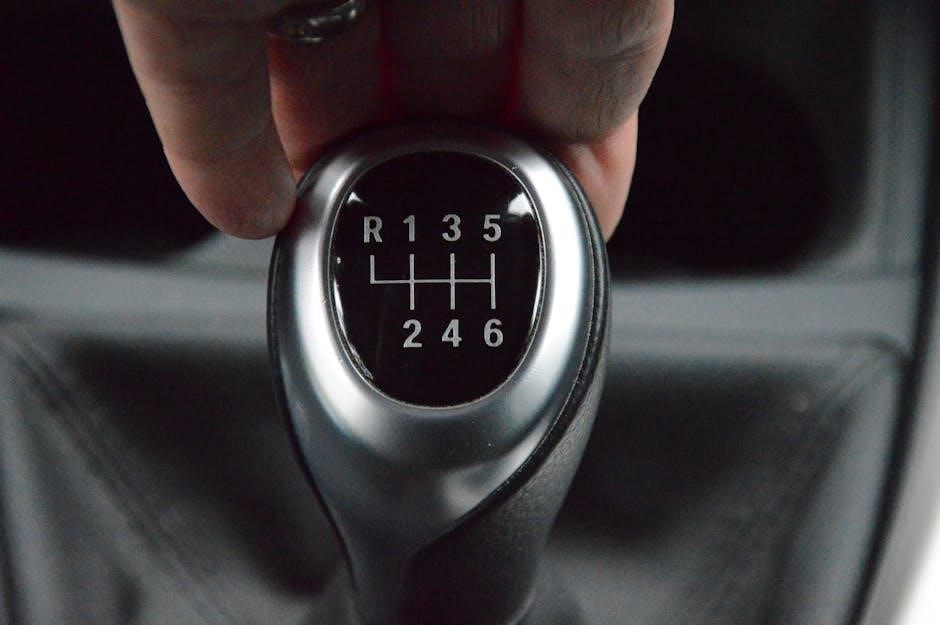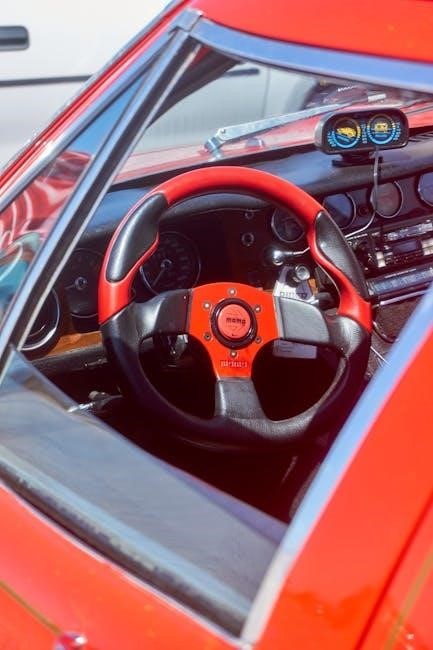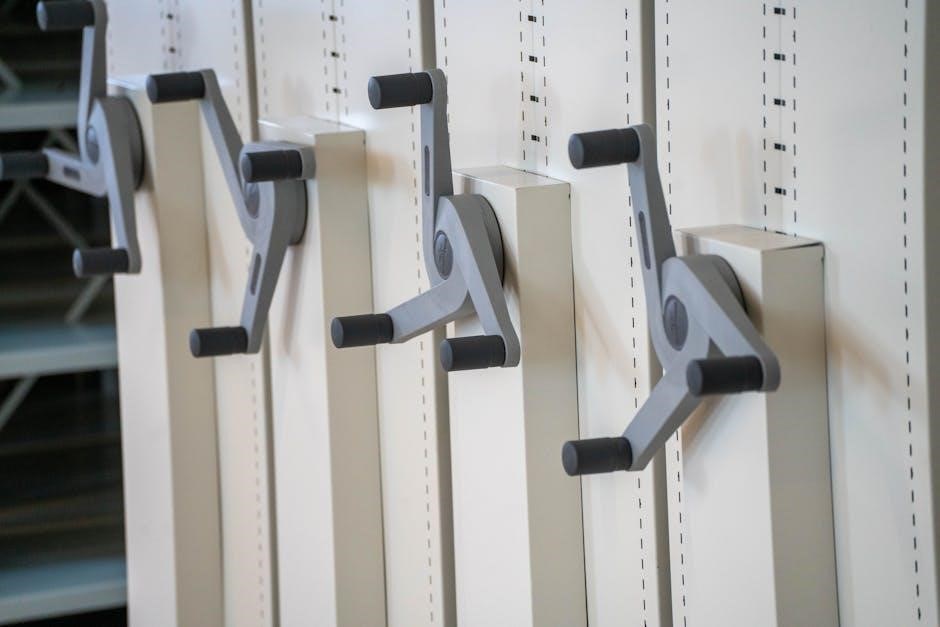Manual transmissions are gear systems controlled by the driver using a clutch and gearshift‚ offering precise control over speed and torque. Torque converters‚ on the other hand‚ are fluid couplings that connect the engine to the transmission in automatic vehicles‚ enabling smooth acceleration without manual intervention. While manual transmissions rely on a clutch system to engage and disengage gears‚ torque converters serve as a bridge between the engine and automatic transmission‚ allowing the engine to run independently of the transmission speed. This fundamental difference defines their roles in vehicle operation.
1.1 Definition of Manual Transmissions
A manual transmission is a type of gearbox that requires the driver to manually select and engage gears using a clutch pedal and a gearshift. It allows the driver to control the torque and speed ratio by mechanically coupling the engine to the transmission through a clutch system. Unlike automatic transmissions‚ manual transmissions do not use a torque converter; instead‚ they rely on the driver’s input to synchronize engine speed with the desired gear. This direct control enables precise acceleration and deceleration‚ making manual transmissions popular for their driving engagement and fuel efficiency.
1.2 Understanding Torque Converters
A torque converter is a fluid coupling device in automatic transmissions that connects the engine to the transmission‚ enabling smooth power transfer without manual intervention. It allows the engine to continue running while the vehicle is stationary and facilitates automatic gear shifting. Unlike manual transmissions‚ which use a clutch for driver-controlled engagement‚ torque converters rely on fluid dynamics to multiply torque at low speeds‚ enhancing acceleration from a standstill. This makes them essential for the operation of automatic vehicles‚ providing seamless power delivery without driver input.

The Role of Torque Converters in Automobiles
Torque converters act as fluid couplings‚ enabling smooth power transfer from the engine to the transmission in automatic vehicles. They allow the engine to run independently of transmission speed‚ facilitating seamless acceleration and gear shifting without manual intervention.
2.1 Functionality in Automatic Transmissions
Torque converters are integral to automatic transmissions‚ enabling smooth power transfer from the engine to the transmission. By using fluid pressure‚ they allow the engine to operate independently of the transmission speed‚ eliminating the need for manual gear shifting. This facilitates seamless acceleration and deceleration‚ ensuring optimal performance across various driving conditions. The torque converter’s ability to multiply torque at low speeds enhances vehicle responsiveness‚ making it a critical component in providing a comfortable and efficient driving experience.
2.2 How Torque Converters Differ from Clutches
Torque converters and clutches serve similar purposes but operate differently. A torque converter is a fluid coupling that transfers power from the engine to the transmission in automatic vehicles‚ allowing smooth acceleration without manual intervention. Unlike clutches in manual transmissions‚ which mechanically engage and disengage the engine from the transmission‚ torque converters use fluid pressure to multiply torque at low speeds‚ enabling seamless power delivery. This eliminates the need for manual gear shifting‚ making driving more accessible and reducing driver effort.

Do Manual Transmissions Use Torque Converters?
Manual transmissions typically do not use torque converters. Instead‚ they utilize a clutch system to engage and disengage the engine from the transmission‚ allowing manual gear shifts.
3.1 The Clutch System in Manual Transmissions
The clutch system in manual transmissions is a mechanical component that connects and disconnects the engine from the transmission. When the driver presses the clutch pedal‚ it disengages the engine‚ allowing gear shifts without grinding. Upon release‚ the clutch engages‚ transferring power back to the transmission. This direct control enables precise shifting and efficient power delivery‚ making it essential for manual operation. Unlike torque converters‚ clutches rely on mechanical friction rather than fluid coupling‚ ensuring a more driver-centric experience.
3.2 Why Manual Transmissions Do Not Typically Use Torque Converters
Manual transmissions do not use torque converters because they rely on a clutch system for engine disengagement. Torque converters are fluid couplings that automatically manage power transfer‚ which conflicts with the manual‚ driver-controlled nature of manual transmissions. The clutch provides a direct mechanical connection‚ offering precise control over power delivery and gear shifts. Torque converters‚ designed for automatic transmissions‚ would introduce unnecessary complexity and reduce the driver’s ability to manually manage engine and transmission synchronization.

Comparing Manual and Automatic Transmissions
Manual transmissions require driver engagement with a clutch and gearshift‚ offering control and efficiency. Automatics use torque converters for smooth‚ hands-off gear changes‚ prioritizing convenience over driver involvement.
4.1 Gear Shifting Mechanisms
Manual transmissions rely on a driver-operated clutch and gearshift to manually select gears‚ ensuring direct control over speed and torque. Automatic transmissions‚ however‚ use a torque converter to fluidly shift gears without driver intervention‚ providing smooth acceleration. Manual systems require active engagement‚ while automatics rely on hydraulic or electronic controls to adjust gear ratios seamlessly. This fundamental difference in shifting mechanisms defines the driving experience‚ with manuals offering precision and automatics emphasizing convenience.
4.2 Performance and Driver Involvement
Manual transmissions generally offer superior performance and driver engagement due to direct control over gear shifts‚ enabling precise acceleration and responsiveness. Automatics‚ equipped with torque converters‚ prioritize convenience and smooth power delivery‚ often sacrificing some driver involvement. However‚ advancements in automatics‚ like dual-clutch systems‚ have narrowed this gap. Manual drivers experience a more connected‚ tactile driving experience‚ while automatics cater to ease of use‚ especially in traffic-heavy conditions. The choice between the two often comes down to personal preference and driving context.

The Role of the Clutch in Manual Transmissions
The clutch is a critical component in manual transmissions‚ enabling drivers to engage and disengage the engine from the gearbox. It allows smooth gear transitions‚ preventing jerks during shifts and ensuring control over power delivery. The clutch’s friction-based operation contrasts with the fluid coupling of torque converters‚ providing a direct‚ mechanical connection between the engine and transmission. This system demands driver input‚ fostering a more interactive and precise driving experience compared to automatic transmissions.
5.1 How the Clutch Engages and Disengages
The clutch in a manual transmission engages and disengages through driver input via the clutch pedal. When pressed‚ it disengages the engine from the transmission‚ allowing gear shifts without grinding. Releasing the pedal re-engages the clutch‚ reconnecting the engine to the transmission. This process relies on friction and centrifugal force‚ enabling smooth power transfer and precise control over gear changes. The driver’s skill in timing the pedal press and release ensures seamless transitions‚ making the clutch integral to manual transmission operation.
5.2 Advantages of Clutch Systems Over Torque Converters
Clutch systems in manual transmissions offer several advantages over torque converters. They provide direct engine control‚ enabling precise acceleration and deceleration. Clutches allow drivers to fully disconnect the engine‚ reducing wear during stops. Unlike torque converters‚ clutches don’t rely on fluid dynamics‚ eliminating the risk of fluid-related failures. Additionally‚ clutches typically require less complex maintenance and are lighter‚ contributing to better fuel efficiency. This direct mechanical connection enhances driver engagement and performance‚ making clutches a preferred choice for driving enthusiasts seeking more control and responsiveness behind the wheel.

Torque Converter vs. Clutch: Key Differences
Torque converters use fluid to transfer power smoothly‚ while clutches rely on mechanical friction. Converters enable engine independence from transmission speed‚ whereas clutches provide direct driver control.
6.1 Operational Differences
Torque converters operate using fluid to transfer power‚ allowing the engine to run independently of the transmission speed. In contrast‚ clutches rely on mechanical friction‚ requiring manual engagement and disengagement. This fundamental difference impacts how power is delivered: torque converters enable smooth‚ automatic acceleration‚ while clutches provide direct driver control over gear shifts. The fluid coupling in converters allows for torque multiplication‚ enhancing low-speed performance‚ whereas clutches offer a more direct connection‚ often preferred for precise control and efficiency in manual transmissions.
6.2 Maintenance and Complexity
Torque converters generally require less frequent maintenance compared to clutches‚ as they have fewer wear-prone components. However‚ when issues arise‚ repairs can be more complex due to their fluid-based operation and internal mechanisms. Clutches in manual transmissions‚ while simpler in design‚ typically need more frequent servicing because of friction plate wear. Replacing a clutch often involves significant labor‚ as it requires removing the transmission. This makes manual systems more maintenance-intensive but less complex overall compared to torque converter-equipped automatics.

Specialized Applications and Exceptions
Some specialized systems‚ like dual-clutch transmissions‚ blend manual and automatic traits. Certain extreme applications use torque converters with manual transmissions for unique performance requirements‚ defying traditional norms.
7.1 Dual-Clutch Transmissions
Dual-clutch transmissions (DCTs) combine elements of manual and automatic systems‚ using two clutches to pre-select gears. Unlike traditional manuals‚ DCTs automate shifting without a torque converter‚ offering rapid gear changes. This design enhances performance and efficiency‚ making it popular in high-performance vehicles. While DCTs resemble manuals in operation‚ they eliminate the need for driver input‚ providing a smoother experience. This hybrid approach bridges the gap between manual control and automatic convenience‚ appealing to drivers seeking both speed and ease.
7.2 Semi-Automatic and Electrohydraulic Systems
Semi-automatic and electrohydraulic systems blend manual and automatic transmission features. These systems use an automated clutch‚ eliminating the need for a torque converter. Electrohydraulic systems employ electronic controls to manage gear shifts‚ reducing driver effort. They are commonly found in high-performance or specialized vehicles‚ offering precise control while maintaining ease of use. These systems enhance driving accessibility without compromising performance‚ making them a versatile option for drivers seeking a balance between manual and automatic functionalities.

The Future of Manual Transmissions
Modern innovations are making manual transmissions more accessible and user-friendly‚ reducing the skill required for operation. These advancements ensure manuals remain relevant for everyday drivers and enthusiasts alike.
8.1 Innovations in Manual Transmission Technology
Modern manual transmissions are evolving with advancements like dual-clutch systems and electrohydraulic actuation‚ making shifting smoother and more efficient. These innovations reduce the skill required for operation‚ broadening their appeal. Dual-clutch transmissions‚ for instance‚ combine the precision of manuals with the convenience of automatics‚ offering rapid gear changes. Additionally‚ gearshift systems now incorporate sensors and software to optimize performance‚ ensuring manual transmissions remain competitive in a market dominated by automatics. These technologies keep manual transmissions relevant for both enthusiasts and everyday drivers.
8.2 The Role of Torque Converters in Modern Manual Systems
While manual transmissions traditionally rely on clutches‚ some modern systems experiment with torque converters to enhance performance. These setups‚ often in extreme applications‚ use torque converters to improve low-speed maneuverability and torque multiplication. However‚ this is unconventional‚ as manuals typically prioritize direct driver control. In such cases‚ torque converters are adapted to work alongside manual gears‚ offering unique advantages like smoother engagements. This innovation bridges the gap between manual precision and automatic convenience‚ though it remains niche due to complexity and cost considerations.
Manual transmissions do not use torque converters; they rely on clutches for engagement. Torque converters are exclusive to automatic transmissions‚ enabling smooth‚ driverless gear shifts and acceleration.
9.1 Summary of Key Points
Manual transmissions use a clutch system to engage and disengage gears‚ while automatic transmissions rely on torque converters for smooth‚ automatic shifting. Torque converters act as fluid couplings‚ allowing the engine to operate independently of the transmission speed‚ whereas clutches in manual systems provide direct driver control. Manual transmissions are generally more efficient and offer better driver involvement‚ but lack the convenience of automatics. Specialized systems like dual-clutch transmissions blend elements of both‚ offering performance and efficiency. Understanding these differences helps drivers choose the best system for their needs.
9.2 Final Thoughts on Manual Transmissions and Torque Converters
Manual transmissions offer precision and control‚ making them ideal for performance driving‚ while automatics with torque converters provide convenience. Manual systems eliminate the need for torque converters‚ relying instead on the clutch for gear changes. The choice between the two often comes down to personal preference and driving habits. While manual transmissions are simpler and more efficient‚ automatics with torque converters offer ease of use. Both systems have their unique advantages‚ catering to different driver needs and vehicle applications.